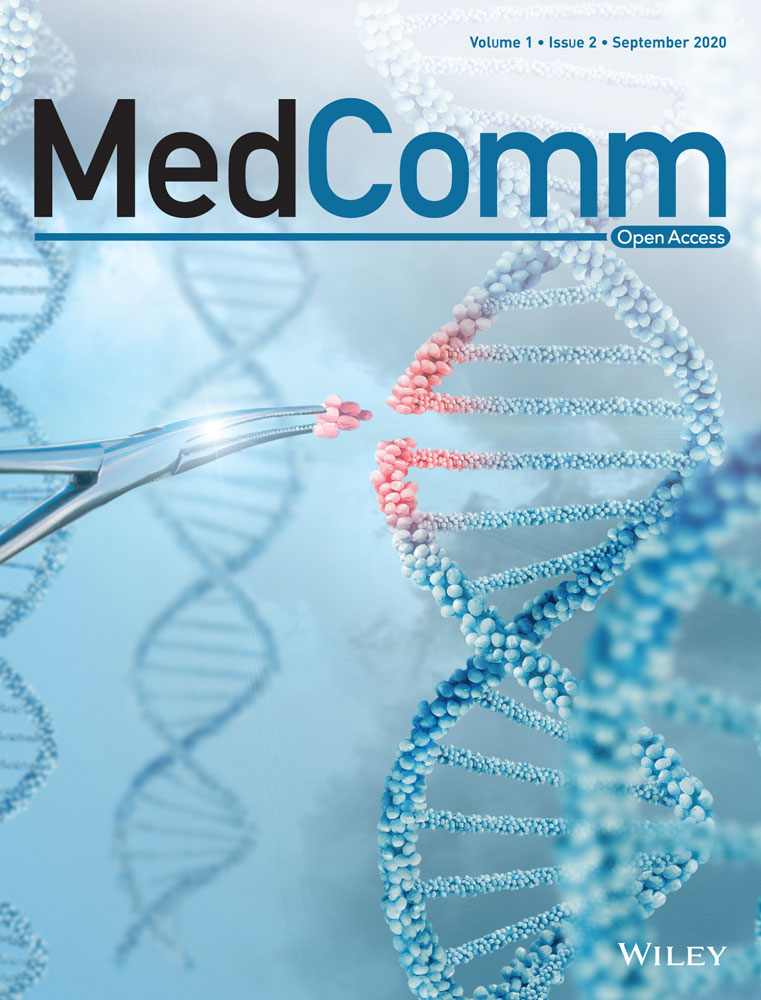Interference of miR-107 with Atg12 is inhibited by HULC to promote metastasis of hepatocellular carcinoma
Haiming Zhang, Shipeng Li, and Haixu Xu contributed equally as joint first authors.
Abstract
Highly upregulated in liver cancer (HULC) had a significant predictive effect on tumor growth and metastasis of hepatocellular carcinoma (HCC); however, the mechanisms of HULC on HCC still need to be clarified. We attempted to determine the roles of HULC and miR-107 in autophagy and invasion of HCC. HULC siRNA reduced the level of autophagy. The impact of HULC siRNA on invasion can be reversed by activating autophagy in HCC cell lines. Further studies on HULC and autophagy were conducted. An interacting sequence between HULC and miR-107, as well as miR-107 and Atg12, was predicted by software. The relationship of each pair of molecules was confirmed by luciferase reporter assays. The negative impacts of miR-107 on autophagy and invasion were proved in HCC cell lines. The inhibitor of miR-107-promoted invasion can also be reversed by Atg12 siRNA. The changes of miR-107, Atg12, epithelial-mesenchymal transition, and autophagy in transplanted tumors of mouse models also confirmed the results in HCC cell lines. Finally, we find that HULC acts as an endogenous sponge, which abolishes the binding of miR-107 on the Atg12 3′-UTR and promotes autophagy and metastasis of HCC.
1 INTRODUCTION
Highly upregulated in liver cancer (HULC) was proposed as a diagnosis biomarker in hepatocellular carcinoma (HCC).1-3 HULC promotes tumorigenesis by its impacts on multiple pathways.2, 4-8 Researchers found in vitro that HULC positively regulates the invasion or migration of gastric cancer cells.9 Epithelial-mesenchymal transition (EMT)10 is a key process of the formation of circulating tumor cells11 or metastases.12, 13 It was reported that EMT was reversed after deletion of HULC,9 which also supported the role of HULC on tumor dissemination. Autophagy, a mechanism of degradating and recycling of long-lived proteins and organelles,14 was also correlated to EMT.15-19 Both of HULC and autophagy were involved in EMT and the progression of tumors. The relationship of HULC and autophagy should be cleared and the role of molecules involved in tumor invasion should be demonstrated.
MiRNAs are noncoding RNAs that plays regulatory roles in multiple diseases and cancers.20-22 MiRNAs can exert impacts on the growth, EMT, and metastasis of tumors by regulating autophagy.23 Some LncRNAs may act as ceRNA to downregulate miRNAs expression and reverse the inhibitory effect of miRNAs.24, 25 It showed a potential way of HULC acting on downstream molecules to regulate autophagy, EMT, or metastasis. In the current study, the role of autophagy in HULC-regulated pathway was studied. Finally, we found that HULC promotes HCC invasion by a HULC/miR-107/Atg12 axis.
2 METHODS
2.1 Antibodies, RNAs, and viruses
Antibodies against Atg5, Atg7, Atg12, MMP-2, MMP-9, LC3, β-catenin, Claudin-1, and β-actin (1:1500, CST, USA) were used in western blot test. LV-HULC siRNA and GFP-RFP-LC3 adenovirus were obtained from the Hanbio Co, Ltd (Shanghai, China). HULC siRNA, Atg12 siRNA, and the mimic and inhibitor of miR-107 were purchased from the RiboBio Co, Ltd (Guangzhou, China).
2.2 Culture and treatment of cells
BEL-7402 and SMMC-7721, two human HCC cell lines, were purchased from ATCC (Manassas, VA, USA), which were grown in RMPI1640 medium (Biological Industries, Kibbutz Beit-Haemek, Israel). The above chosen HCC cell lines were supplemented with 10% FBS and 100 µg/mL each of penicillin and streptomycin (Gibco, New York, NY, USA). Autophagy was activated by Rapamycin (50 nM, Sigma Aldrich, St. Louis, MO, USA) and inhibited by 3-methyladenine (3-MA; 75µM, Selleck Chemicals, Houston, TX, USA). Cells were transfected by Lipofectamine 3000 (Invitrogen, Carlsbad, CA, USA).
2.3 Animal experiments
All animal experiments were conducted after the approval of the ethics committee of Beijing Friendship Hospital. The transfected SMMC-7721 cells were injected subcutaneously into the flanks of each 4-week-old Balb/c athymic nude mice. After 5 weeks of tumor growth, mice were euthanized, and necropsies were performed. SMMC-7721 cells were injected subcutaneously into the left liver lobes of each nude mouse. Five weeks after SMMC-7721 cells implantation, the mice were sacrificed to examine via hematoxylin and eosin (H&E) staining.
2.4 Dual luciferase reporter assay
HCC cells were co-transfected with either miR-NC/miR-107 mimic, luciferase reporter comprising 3′-UTR of Atg12, or wild/mutant Atg12 fragment. Dual luciferase reporter assay was detected according to the manufacturer's protocol.
2.5 Cell EMT model
SMMC-7721 and BEL-7402 cells were seeded in DMEM containing 1% FBS with or without TGF-β1 (10 ng/mL, PeproTech, USA), and then culture was continued for an additional 5 days.
2.6 RNA extraction and quantitative real-time reverse transcription polymerase chain reaction analysis
Total cellular RNA was extracted and real-time reverse transcription polymerase chain reaction (RT-PCR) were performed according to the manufacturer's instructions.
2.7 Western blot test, invasion/migration assay, immunohistochemical staining, and immunofluorescence staining
Western blot test, invasion/migration assay, immunohistochemical (IHC) staining, and immunofluorescence (IF) staining were conducted as reported previously.4, 26
2.8 Statistical analysis
A SPSS 22.0 statistical software package was used for statistical analysis. The significance of differences was estimated by t-test, one-way analysis of variance, χ2 test, or Mann-Whitney U test. All tests performed were two sided and the criterion for statistical significance was taken as P < .05.
3 RESULTS
3.1 HULC promotes invasion/migration by activating autophagy
According to our previous investigation,4 high levels of HULC were found in BEL-7402 and SMMC-7721 in comparison with L02. HULC siRNA was selected to investigate its function by blocking its interaction with other molecules, because over expressing HULC was supposed to have a ceiling effect in this context. In the migration and invasion assays, fewer cells migrated or invaded into the lower surface of filter (Figure 1A) and it showed a compromised ability of invasion/migration in HCC cells harboring HULC siRNA. Low expressions of MMP-2 and MMP-9 in HULC siRNA group were also found by western blot analysis (Figure 1B). Both of these two enzymes can mediate basement membrane breakdown and invasion. These results showed a negative role of HULC siRNA on migration/invasion of liver cancer cells.
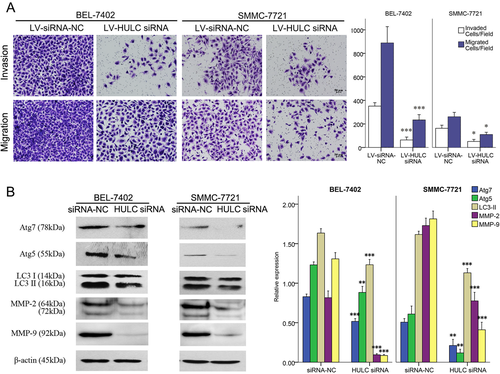
In HCC cells treated with HULC siRNA, the levels of LC3-II, Atg5, and Atg7 decreased significantly, as well as the level of Atg12 shown by IF staining (Figures 1B and 2A), suggesting the reduction of Atg12 conjugation system (Atg12/Atg7/Atg5) and autophagy. Then, autophagy in HCC cells was visualized using an mRFP-GFP-LC3 adenovirus vector and observed under a confocal laser scanning microscope. Comparing with the HULC siRNA NC, there were significant decreases in the number of green, red, or merged fluorescent puncta after HULC siRNA administration (Figure 2B). It confirmed a positive role of HULC on autophagy.
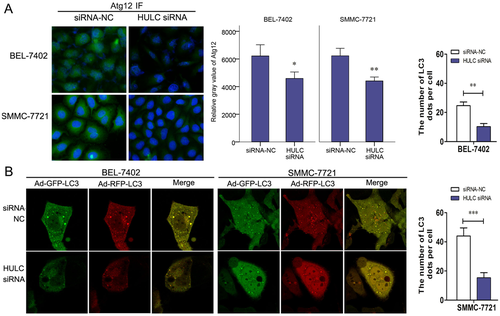
After the roles of HULC in invasion/migration and autophagy were found, the impact of autophagy on HULC-regulated invasion/migration was studied. In transwell assays, the invasion/migration of HULC siRNA-treated cells was increased after Rapamycin administration and decreased after 3-MA administration (Figure 3A). Thus, autophagy has a significant impact on invasion/migration as HULC. Autophagy promoted by HULC can serve as one of the pathways in HULC-regulated invasion/migration.
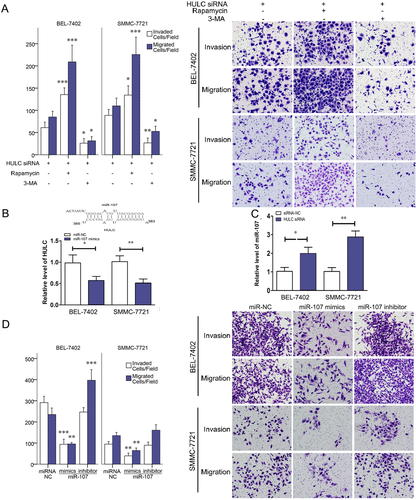
3.2 HULC promotes invasion/migration by inhibiting miR-107
To clarify the underlying mechanism by which HULC has impact on autophagy, a direct target of HULC was predicted using a TargetScan6.2 bioinformatics algorithm and a miRanda software. In alignment prediction, HULC was aligned with a sequence of miR-107 (Figure 3B). Then, further experiments were conducted in cell lines. Compared with cells treated with siRNA-NC, HULC siRNA-transfected HCC cells have a significant increase in level of miR-107 quantified by Quantitative Real-time Polymerase Chain Reaction (qRT-PCR), and a reduction of HULC expression was found after miR-107 mimic introduction (Figures 3B and 3C). All these results confirmed negative regulations between HULC and miR-107 by binding with each other.
The impact of miR-107 on cancer cell invasion/migration was studied by a transwell assay with HCC cells. The numbers of invading/migrating cells were decreased in miR-107 mimic group and increased in miR-107 inhibitor group (Figure 3D). Western blots analyses were also made to quantify proteins in miR-107 mimic- or inhibitor-treated BEL-7402 and SMMC-7721 cells. MMP-9 was found to be decreased in miR-107 mimic group and increased in miR-107 inhibitor group (Figure 4A). β-Catenin and claudin-1, two hallmarks of EMT, were compared among control, TGF-β, and TGF-β + miR-107 mimic groups. Significant reductions of β-catenin and claudin-1 were found after a miR-107 mimic was added to the TGF-β-incubated cells (Figure 4B). These results demonstrated that miR-107 inhibits the invasion, migration, and EMT among liver cancer cells.
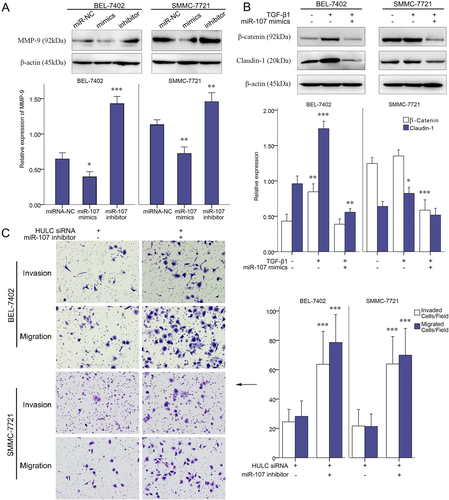
After knocking HULC down by HULC siRNA, invasion/migration of HCC cells in transwell assays was promoted by a miR-107 inhibitor (Figure 4C). Thus inhibiting miR-107 has a positive role in the invasion/migration. Inhibiting miR-107 by HULC can serve as a pathway in HULC-regulated invasion/migration.
3.3 miR-107 regulates the expression of Atg12
Because autophagy and miR-107 both had roles in HULC-regulated pathway, the impact of miR-107 on autophagy was studied. After treating with miR-107 mimic or inhibitor, mRFP-GFP-LC3 was overexpressed by mRFP-GFP adenoviral vector in HCC cells. The fluorescent puncta of autophagosomes were observed by a confocal laser scanning microscope. Comparing with the miR-NC group, the numbers of green, red, and merged fluorescent puncta decreased in miR-107 mimic group and increased in miR-107 inhibitor group (Figure 5A). Similarly, Atg12 and LC3-II were found to be decreased in miR-107 group and increased in miR-107 inhibitor group (Figure 5B). These results confirmed the inhibitive role of miR-107 on autophagy.

A conjugating sequence of miR-107 to the Atg12 3′-UTR (position 253–259) was also found by the abovementioned software (Figure 6A). In Figure 6B, miR-107 mimic significantly decreased luciferase activity in cells treated by the reporter plasmid with wild-type targeting sequence of Atg12 mRNA, but not with reporter plasmid with mutated Atg12 mRNA. To further confirm the role of miR-107 in the expression of Atg12, we detected the Atg12 expression in HCC cells transfected with miR-107 mimic or miR-107 inhibitor. A reduced expression of Atg12 in miR-107 mimic group was found by western bot analysis, as compared with miR-107 inhibitor group (Figure 6C).
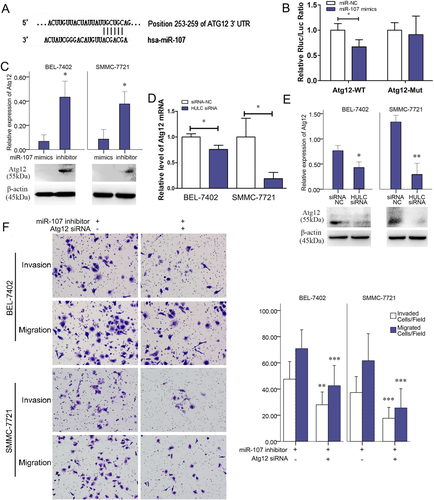
3.4 Atg12 is critical in HULC/miR-107-regulated invasion/migration
Similar to the Atg12 expression found in miR-107 mimic group (Figure 6C), Atg12 were apparently downregulated in HULC siRNA-transfected cells (Figures 6D and 6E). These results confirmed the regulation of miR-107 and HULC on Atg12. HULC may act as an endogenous sponge, which abolishes the binding of miR-107 on the Atg12 3′-UTR. In transwell assay, invasions/migrations of miR-107 inhibitor-treated HCC cells were suppressed by co-treatment of Atg12 siRNA (Figure 6F). Thus, Atg12 is also critical in the HULC/miR-107-regulated invasion/migration.
3.5 MiR-107, Atg12, EMT, and autophagy in transplanted tumors of mouse models
After transfecting with a LV-HULC siRNA, SMMC-7721 cells were implanted into nude mice subcutaneously (Figure 7A). In sections of tissues around the tumor, less invaded tumor cells were found in HULC siRNA group (Figure 7A). In HULC siRNA group, a relative low level of Atg12 mRNA and high level of miR107 were found by qRT-PCR (Figure 7A). Autophagy activation represented as LC-II in western blots analysis also decreased in HULC siRNA group (Figure 7B). mRFP-GFP LC3 adenoviral vectors were injected before tumor harvesting and fluorescent puncta of autophagosomes on the frozen sections were compared between groups. The numbers of fluorescent puncta decreased in HULC siRNA group, compared with siRNA NC group (Figure 7C). Atg12 visualized by IF staining also decreased in HULC siRNA group (Figure 7D). Compared to siRNA-NC groups, the expression of MMP-2 and N-cadherin decreased in HULC siRNA group, and the expression of E-cadherin increased, which suggested a compromised ability of invasion or EMT (Figures 7E and 7F).
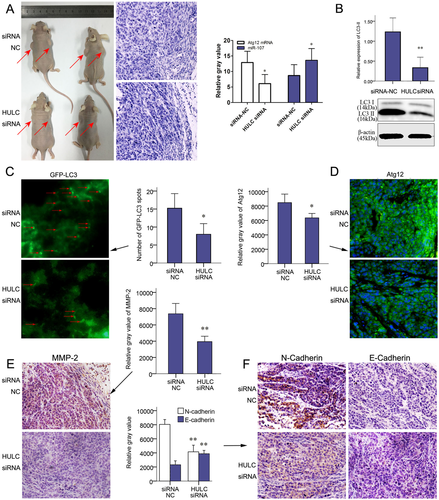
SMMC-7721 cells with HULC siRNA or siRNA-NC were in situ injected into mouse livers. More tumor nodules within and around liver were found in siRNA-NC group (Figure 8A). There were also more pulmonary metastatic lesions in siRNA-NC group than HULC siRNA group (Figure 8A). On the sections of pulmonary metastatic tumors, IF stain of Atg12 decreased in HULC siRNA group (Figure 8B). IHC staining of intrahepatic tumor sections showed a decreased MMP-2 and an increased E-cadherin in HULC siRNA group (Figure 8C).

4 DISCUSSION
The level of HULC was correlated with clinical outcome in many cancers.9, 27, 28 Hämmerle et al found HULC higher in low-grade and low-stage HCC.29 Xie et al reported that higher HULC expression was associated with Tumor-Lymph Node-Metastasis (TNM) stages of HCC.3, 30 Li et al reported the predictive role of HULC on tumor growth and metastasis of HCC.30 However, the mechanisms of HULC in HCC still need to be cleared.
It was reported that autophagic flux can be induced by environmental stresses.32 Further studies found autophagy promoted not only the survival of dormant tumor cells and disseminating them to circulation but also directly regulated the EMT and also worked as a responsor in the metastatic cascade.15, 16 Autophagy may be involved in HULC-regulated pathway. To clear the function of autophagy in HULC-regulated liver cancer invasion, autophagy was activated by Rapamycin after HULC was knocked down. Then, the negative impact of HULC siRNA on invasion/migration of liver cancer cells was reversed by activating autophagy (Figure 3A). Thus autophagy is important for HULC to promote invasion. Molecular mechanisms between HULC and autophagy should be cleared.
Atg proteins, such as Atg12 and Atg5, can bind to the autophagic membranes, as key regulators of the autophagic process.33 Unlike P62, the expression of Atg proteins may directly impact the autophagy,34, 35 which was also correlated to differentiation and metastasis of gastric cancer.36 The relation between HULC and expression of these proteins was explored in this study. Instead of direct conjugating sequences between HULC and Atg proteins, a sequence of HULC acting on miR107 and a sequence of miR107 acting on Atg12 were found by a prediction software (Figures 3B and 6A). LncRNA might function as molecular sponges for miRNAs.37-39 According to the findings in conjugating sequences, HULC was hypothesized as a ceRNA sequestering miR-107 and regulates Atg12 indirectly. Then, the role of miR-107 and Atg 12 in HULC-mediated tumor invasion was confirmed in following examinations.
The functions of miR-107 on growth and invasiveness are controversial in different types of carcinomas.40-42 The target molecules of miR-107 and pathways involved have not been fully understood. The affinity between HULC and miR-107 is higher than the affinity between miR-107 and Atg12 mRNA. However, the affinities between miR-107 and some of the other conjugating molecules may be stronger. Thus, miR-107 still has a potential to take part in other processes after its combination with HULC. HULC may remove part of its functions and reserve other functions, such as promoting tumor progression. The cross-talks between molecules conjugating with HULC or miR-107 should also be further investigated. The HULC/miR-107/Atg12 axis serves as a critical pathway to promote autophagy and finally results in metastasis of high HULC expressing HCCs.
ACKNOWLEDGMENT
We thank Professor Rongxin Zhang for his guidance in this work.
AUTHOR CONTRIBUTIONS
ZHM, LSP, and XHX performed the majority of experiments and analyzed the data. LSP and XHX performed the molecular investigations. LSP and XHX participated in treatment of animals. SLY, ZZJ, and YZ designed the research. ZHM wrote the paper.
ETHICS APPROVAL
The approval of animal experiments was acquired from the ethics committee of Beijing Friendship Hospital.
AVAILABILITY OF DATA AND MATERIALS
All data generated or analyzed during this study are included in this published article.
CONFLICT OF INTEREST
The authors declared no conflict of interest.



